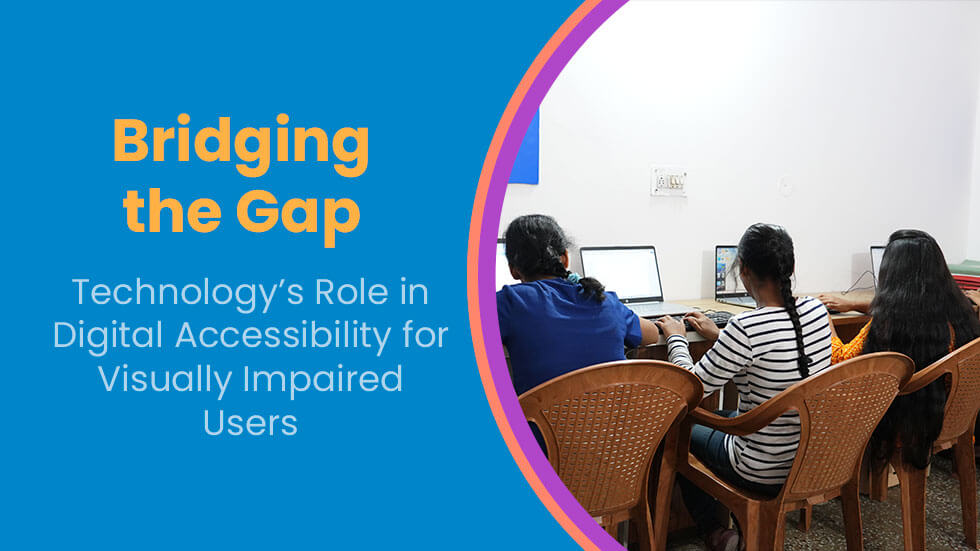
In today’s fast-paced digital world, technology is playing an increasingly crucial role in breaking down barriers and ensuring that people with disabilities can access the same online services, tools, and resources as everyone else. For visually impaired individuals, digital accessibility has long been a challenge, but with the advancements in technology, there is now a wealth of solutions designed to bridge the gap. This blog explores how technology is enhancing digital accessibility for visually impaired users and the impact it is having on their lives.
The Importance of Digital Accessibility
Digital accessibility refers to the practice of ensuring that websites, mobile apps, and digital content are usable by everyone, including people with disabilities. For visually impaired users, this means creating platforms and tools that can be navigated using assistive technologies. In many cases, the digital world can feel like an inaccessible space, with websites, applications, and even documents being difficult or impossible to navigate without sight. However, the rise of innovative assistive technologies is changing this.
Key Assistive Technologies Empowering Visually Impaired Users
-
Screen Readers
Screen readers are software programs that convert text and other on-screen content into speech or Braille. For visually impaired users, these tools are vital for accessing websites, reading emails, or interacting with documents. Popular screen readers like JAWS (Job Access With Speech) and NVDA (NonVisual Desktop Access) have made it possible for blind users to navigate the web efficiently. -
Voice Assistants
Voice recognition software has become a game changer for visually impaired users. Assistants like Amazon’s Alexa, Google Assistant, and Apple’s Siri allow users to control devices, perform online searches, make phone calls, and access information, all through voice commands. This hands-free technology eliminates the need for a visual interface, allowing users to interact with technology intuitively. -
Text-to-Speech (TTS) Tools
Text-to-speech technology converts written text into spoken word. TTS solutions such as Natural Reader and Kurzweil 3000 are widely used by visually impaired individuals to consume online content, read books, and browse the internet. This technology plays a significant role in enhancing accessibility by allowing visually impaired users to listen to content they otherwise would not be able to see. -
Braille Displays
Braille technology continues to evolve, and modern Braille displays are increasingly being integrated with smartphones, tablets, and computers. These devices provide tactile feedback, allowing visually impaired users to read digital content through raised Braille characters. Tools like the Focus 40 Blue and BrailleNote Touch have made it easier for blind individuals to access information in an inclusive and efficient manner. -
AI-Powered Image Recognition
Artificial Intelligence (AI) has made significant strides in improving accessibility for visually impaired users. Tools like Be My Eyes and Aira use AI and crowdsourced assistance to help users identify objects, read text, and navigate their surroundings. These apps connect visually impaired users with sighted volunteers who assist them in real-time via video calls, making it easier for users to interact with the world around them.
How Websites and Apps are Adapting to Accessibility Standards
As digital accessibility becomes more important, web developers and app creators are increasingly prioritizing accessibility in their design processes. Key accessibility standards and guidelines like WCAG (Web Content Accessibility Guidelines) and ADA (Americans with Disabilities Act) compliance help ensure that digital platforms are usable by individuals with disabilities, including the visually impaired.
For example, websites are now integrating features such as:
- Alt Text for Images: Providing descriptive alt text for images allows screen readers to describe visual content to blind users.
- Keyboard Navigation: Ensuring websites can be fully navigated using a keyboard (without relying on a mouse) is essential for users with limited vision or motor skills.
- Contrast and Color Customization: Websites are being designed with adjustable contrast and color schemes to make text more readable for users with low vision.
These efforts are crucial in making the digital world more inclusive for all users, including those with visual impairments.
The Role of Mobile Apps in Enhancing Digital Accessibility
Mobile applications have become a central part of daily life, and many are now designed with accessibility features that cater to visually impaired users. For instance, iOS and Android both offer built-in accessibility features such as VoiceOver (iOS) and TalkBack (Android), which read aloud text on the screen, allowing users to interact with their smartphones and tablets.
Additionally, there are specific mobile apps tailored for the visually impaired, such as:
- Seeing AI: An app by Microsoft that uses AI to narrate the world around the user, reading text, identifying objects, and recognizing people.
- Aira: A service that connects users with trained agents who can provide visual descriptions of their surroundings in real-time.
These apps are transforming the way visually impaired users engage with the digital world, making tasks like online shopping, navigating public spaces, and even socializing much easier.
The Future of Digital Accessibility for Visually Impaired Users
The future of digital accessibility is bright, with ongoing innovations in AI, machine learning, and other technologies that promise to further enhance the digital experiences of visually impaired users. The integration of 5G technology will also lead to faster and more reliable access to assistive tools and resources, opening up new possibilities for real-time assistance and remote support.
Moreover, the growing focus on universal design and inclusive tech means that more companies and developers are adopting accessibility as a fundamental aspect of their products and services. As awareness increases and demand for accessible solutions grows, the digital divide between sighted and visually impaired individuals will continue to narrow.
Conclusion
Technology has made significant strides in enhancing digital accessibility for visually impaired users. From screen readers and voice assistants to AI-powered tools and Braille displays, these innovations are empowering individuals with visual impairments to fully engage with the digital world. As technology continues to evolve, the future holds even greater promise for creating a more inclusive and accessible digital environment for all users.
By embracing digital accessibility, we can ensure that no one is left behind in this digital age. Technology’s role in bridging the gap for visually impaired individuals is not only about improving their access to information but also about fostering independence, inclusion, and empowerment.





